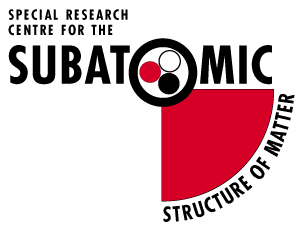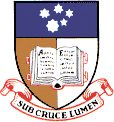

![]()
Abstracts for the
Workshop on Lattice QCD
December 7 through 18, 1998
![]()

University of Adelaide
Improved Action Gauge Fixing: Formalism and Implementation
Gauge fixing is often required in lattice calculations. This could be because one wants to calculate gauge dependent quantities such as the gluon propagator or Bethe-Salpeter amplitude, or as part of a preconditioning program to, for example, accelerate the inversion of the fermion matrix. I will explain how gauge fixing is done on the lattice, and briefly review current techniques. It will be shown how Landau gauge fixing may be accomplished to order a4, suitable for use with improved gluon actions. The emphasis will be on parallelisable methods.
Timelike Correlation Functions in the (2+1)D U(1) Lattice Gauge Theory Using Green's Function Monte Carlo Techniques
We describe attempts to calculate timelike correlation functions using Green's function Monte Carlo methods for the purpose of calculating mass gaps in Hamiltonian lattice gauge theories, using the well studied U(1) Yang-Mills theory in (2+1) dimensions as an example.
Exploring Hadron-Hadron Interactions in Lattice QCD
An effective residual interaction (potential) for a meson-meson system is computed in lattice QCD. The theoretical framework is explained and its application to the I=2 channel S-wave interaction of the pi-pi systems discussed. Scattering phase shifts are computed and compared to experimental results.
Changing From a Skeptic to a Believer: Confinement by Center Vortices
I present the results of a numerical experiment which shows, against naive expectations, that (i) center vortices are responsible for confinement; (ii) the Abelian monopole condensate disappears when center vortices are removed.
On Lattice Chiral Gauge Theories
In this talk, I review the general problem of fermion species doubling, and it's relation to chiral symmetry. I then discuss several attempts to construct lattice chiral gauge theories, with emphasis on the gauge-fixing approach.
Strange Results with Staggered Fermions: the Delta I=1/2 Rule and ms
I report on a calculation of the K to pi matrix elements of the delta S=1 weak Hamiltonian, and on a nonperturbative determination of the strange quark mass.
Heavy Quarks on Anisotropic Lattices
New Columbia Domain Wall Fermion Results
Exploring Baryon Resonances on the Lattice
I will report exploratory calculations on the extraction of 1/2- and 3/2- baryon resonances on the lattice using tadpole-improved actions.
A Stochastic Monte Carlo Algorithm with Fermion Determinant
We propose a stochastic Monte Carlo algorithm for full QCD in which the fermion determinant is estimated with noise and unbiased subtraction to reduce the variance. The probability-bound violation which plagues Kennedy-Kuti's linear accept/reject algorithm is resolved by adopting the Metropolis accept/reject step. We study the efficiency of decorrelating Trlog M in Hybrid Monte Carlo algorithm with pseudofermions. The feasibility of using this algorithm to study finite density in the canonical ensemble will be discussed.
Nucleon Strangeness with Improved Uncertainties
Since the report of the SAMPLE Collaboration suggesting the strange-quark contribution to nucleon magnetic moments, GMs(0), may be greater than zero, numerous models have appeared supporting positive values for GMs(0). Using an approach in which ratios of quark-sector magnetic-moment contributions are used, I will illustrate the bizarre physics associated with GMs(0) > 0, and emphasize the systematic advantages in working with such ratios. Chiral extrapolations of the quark-sector magnetic moments remain the most problematic aspect of this approach, and I will describe new methods used to perform separate extrapolations of valence and sea contributions.
The Coupled Cluster Method Applied to LGT
Improved Actions for Staggered Fermions
The Gluon Propagator in Landau Gauge
The infrared and ultraviolet behaviour of the gluon propagator is studied for the pure gauge theory in Landau gauge. Using lattices with different volume and lattice spacing, and studying anisotropies and tensor structure, we are able to identify and control finite volume and finite lattice spacing effects. Various analytic forms for the momentum dependence of the gluon propagator are investigated.
The Role of Pions in Hadron Structure
I will review the role of pions in hadron structure with an emphasis on how this role affects lattice QCD calculations and especially the chiral extrapolations. Particular emphasis will be placed on a recent study of magnetic moments.
Disconnected Amplitudes and Finite Volume Effects
I will discuss the calculation of disconnected graphs in lattice QCD calculations. Different techniques for removing noise from the amplitudes will be presented. I will also present some simple formulas for estimating finite volume effects on energy levels in lattice simulations. These formulas are obtained by integrating wall pressure equations using the asymptotic forms of wave functions.
Relativistic and Other Corrections in Lattice NRQCD
I will review some recent results on the effects of higher order terms of lattice NRQCD on the masses of heavy-light mesons and on the decay constants of quarkonia. Then I will then address how the effects of high-momentum modes (modes near the cut off) creep into the calculations as the quark mass is decreased and the problems encountered in trying to deal with these lattice artefacts.